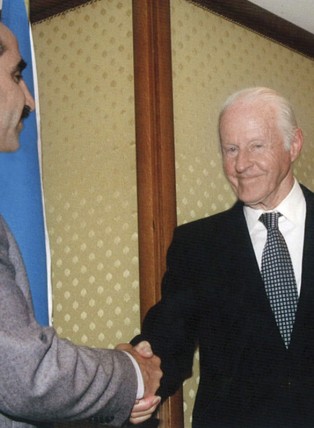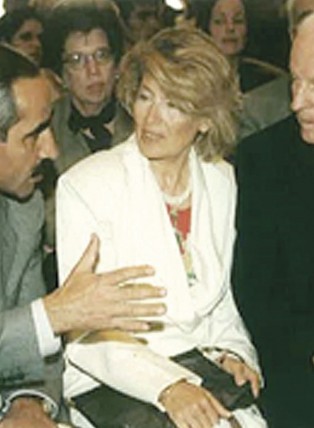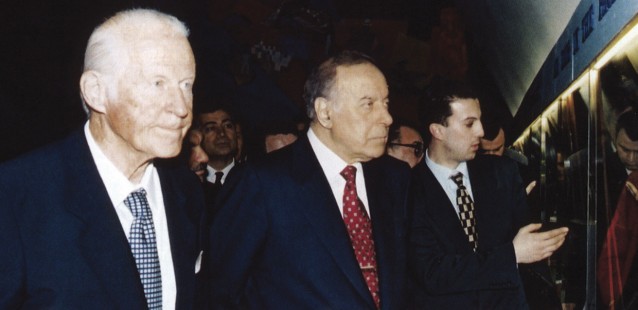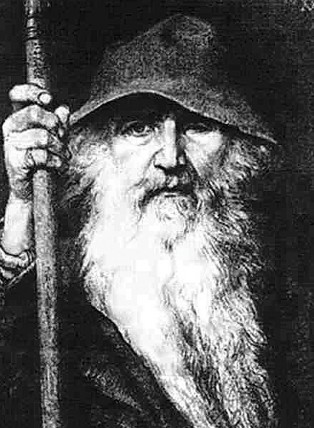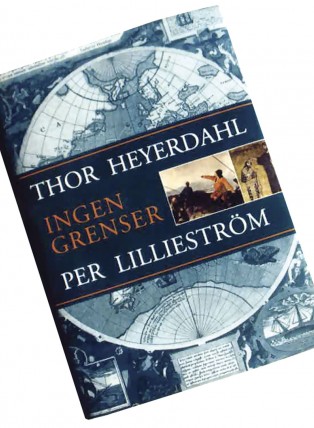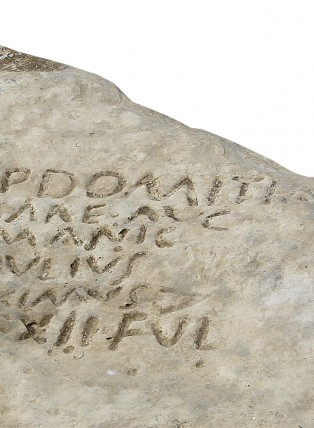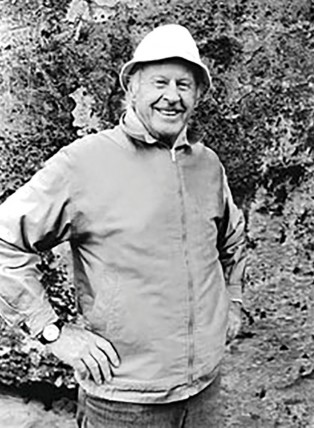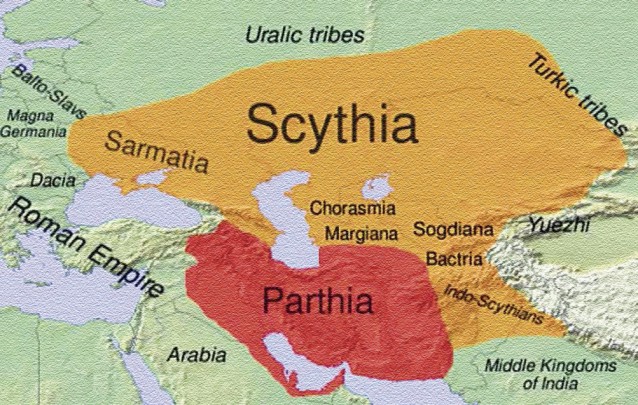Thor Heyerdahl (1914-2002) was a world-renowned explorer and archaeologist who was convinced that there might be connective links between the Caucasus and Scandinavia. He elaborated on these ideas in his book Ingen grenser, Norwegian for No Borders, published by J.M. Stenersens Forlag in Oslo in 1999. In his research he claimed that the Scandinavian god Odin was actually a historical figure who had originated from the Caucasus and then migrated with a large number of his people to Scandinavia and that Scandinavians are the descendants of the people who once lived in the region now known as Azerbaijan.
Heyerdahl’s rich heritage and legacy continue to influence hearts and minds, generate dialogue, multicultural co-operation and build bridges across national borders and political and religious factions. His book The Kon-Tiki Expedition, published in 70 languages, has become a classic. A documentary film of the Kon-Tiki expedition won an Oscar in 1951. Heyerdahl received 11 honorary doctorates from universities in the Americas and Europe. In May 2011, the Thor Heyerdahl Archives were added to UNESCO’s Memory of the World programme. In 2000, the Thor Heyerdahl Institute was established in Lavrik (Norway) with the aim of promoting and developing Thor Heyerdahl’s ideas and principles. The famous Kon-Tiki Museum in Oslo houses original boats and exhibits from Thor Heyerdahl’s world famous expeditions.
Thor Heyerdahl made four visits to Azerbaijan: in 1981, 1994, 1999 and 2000. He was the Honorary President of the Azerbaijan-Norway Friendship Society. What follows is a shortened version of Heyerdahl’s speech delivered at a public forum organised by the Society during his visit to Baku in May 1999.
Azerbaijan connection
I think as science advances, it will become more and more evident that we have more in common with each other than any of us realised a few decades ago. This afternoon I visited the Qobustan caves. From the first time I saw the carvings out there (several years ago), I was attracted to the petroglyphs which feature reed ships. On the way back from Qobustan, I was told that I was supposed to speak tonight. I was told that I should speak about my relationship with Azerbaijan and how it began. I had barely half an hour to prepare myself for this topic, but I hope you will give me half an hour so I can tell you what I’ve been thinking.
The first time I came to Azerbaijan was in 1981. There weren’t many visitors from outside the Iron Curtain who came here in those days. My invitation came from Azerbaijan’s Academy of Sciences. I started thinking about why the Academy of Sciences in Azerbaijan would invite me and it dawned on me that I was in a very unique situation at the time because I was both a member of the New York Academy of Sciences and had received an Honorary Doctorate from the Soviet Academy of Sciences. I didn’t believe in barriers between nations. I believed in people, not political parties.
And so, after the three expeditions on three different oceans, I was invited to visit Azerbaijan. I came here because I had established good contacts with scientists in this country, and I had learned that you had something quite sensational in Qobustan. I came to Azerbaijan as a guest of the Academy of Sciences in Azerbaijan to see the petroglyphs in Qobustan.
The President of the Academy was driving around with me to see this country and all its beautiful nature, and meet the local people and scientists. We went to see the petroglyphs in Qobustan. I learnt about my friend’s family connections the day before I left - he was the brother of the President of Azerbaijan. That was how my friendship with your country started.
The record of Odin says that he came to northern Europe from the land of Asers. I started reading these pages again, and saw that it was not mythology at all; it was history and geography
Due to this friendship that I have with Azerbaijan, when Statoil from Norway came here, I was invited to join the delegation because I knew so many people in your country. And that’s when I became interested in the fact that you have two types of boat petroglyphs in Qobustan. (Heydar Aliyev first met Thor Heyerdahl in August 1981. In 1994, Statoil approached President Heydar Aliyev and asked who they might bring from Norway. Aliyev had commented that the only person he knew was Thor Heyerdahl. - Ed.)
On my first visit, I came to study the reed ships which are similar to the boats of the ancient Mediterranean. But on the second visit, I learned that the people in Azerbaijan call themselves Azeri. I remember from my school days that we have legends in Norway woven into the Norwegian history in such an intricate way that we didn’t know where history starts and mythology ends. But the written history of Norway goes back more than 800 years. Oral traditions about the original homeland of our ancestors were recorded around the year 900 in Iceland and said that we are descendants of the land of the Aser.
Early Scandinavian history
We learned the line of the royal families in Denmark, Sweden and Norway. But we didn’t take the stories about our origins seriously because they were so ancient. We thought it was just imagination, just mythology. The actual years for the lineage of our historic kings began around 800 AD. So we learned about all the kings over the 1,000 years that followed but didn’t take an interest in the earlier names.
But I remember from my childhood that the myths began with the God named Odin. From Odin it took 31 generations to reach the first historic king. The record of Odin says that he came to northern Europe from the land of Asers. I started reading these pages again, and saw that it was not mythology at all; it was history and geography.
Snorri Sturluson, a 13th-century Icelandic historian, who recorded these stories, started by describing Europe, Asia and Africa, all with their correct names, Gibraltar and the Mediterranean Sea with their old Norse names, the Black Sea and the Dardanelles with the names we use today again, and the river Don with its old Greek name, Tanais. So, I realised that this has nothing to do with the gods who lived with the god of thunder, Thor, in the skies. This is on our planet.
Snorri said that the homeland of the Asers was east of the Black Sea. He said this was the land that chief Odin had, a big country. He gave the exact description: it was east of the Black Sea, south of a large mountain range on the border between Europe and Asia, and extended southwards towards the land of the Turks. This has nothing to do with mythology; it was on this planet, on Earth.
Then came the most significant point. Snorri says: At that time when Odin lived, the Romans were conquering far and wide in the region. When Odin learned that they were coming towards the land of Asers, he decided that it was best for him to take his priests, chiefs and some of his people and move to the northern part of Europe.
The Romans were human beings, they were from this planet, and they weren’t mythical figures. Then I remembered that when I came to Qobustan, I had seen a stone slab with Roman inscriptions. I contacted the Academy of Sciences of Azerbaijan. I was taken to the place, and I got the exact wording of the inscription.
There’s a very logical way of figuring out when this was written. It had to be written after the year 84 AD and before the year 97 AD. If this inscription matched Snorri’s record, it would mean that Odin left for Scandinavia during the second half of the 1st century AD. Then I counted the generations of kings, every king up to the grandfather of the king that united Norway into one kingdom, because this information is available - around 830 AD.
In anthropology we reckon 25 years per generation of ruling kings. In modern times, a generation extends to 30 years, but on average the length of a generation in early reigns is 25 years per generation. When you multiply 31 generations by 25 years, you come exactly back to the second half of the 1st century AD. So there is proof that these inscriptions carved by the Romans in stone coincide with the history written almost 800 years ago in Iceland. Here is where history, archeology, geography and physical anthropology come together.
The more I research the topic, the more evidence I find that this part of the planet has played a much more significant role than anybody ever suspected. I am working on a book at the moment together with a colleague, and we are halfway through, describing our observations.
Tarim mummies in China
In the meantime we have contacts with the academies of sciences in 11 countries. We don’t want to leave anything out. The most surprising thing was when we contacted Communist China. They had discovered blond-haired mummies in the Tarim Desert deep inside China, so perfectly preserved in the cold climate and salty earth that you could see the colour of the skin and hair. The Chinese archaeologists were surprised because the mummies were not Mongoloids at all; they suspected that they were Vikings.
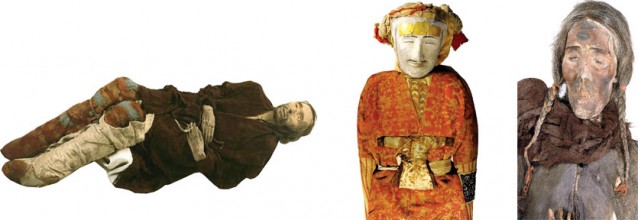 The Tarim Mummies were found in very good condition due to the dryness of the desert and dessication of the corpses. Several leading scholars have traced their origins to Europe or the Caucasus
The Tarim Mummies were found in very good condition due to the dryness of the desert and dessication of the corpses. Several leading scholars have traced their origins to Europe or the Caucasus
But it didn’t make sense to me that the Vikings should be deep inside the deserts of China. When the Chinese archaeologists conducted carbon dating, they determined that the mummies were of Nordic type dating from 1,800 to 1,500 years BC. But the Viking period started around 800 AD. It then became obvious that these mummies were not Vikings that had come to China. Here was a missing link. And again the Caucasus enters into the picture as a mutual migratory centre.
Scythians
But this is not the end of the story. These mummies were dressed in cloth which had been woven, and the colours and patterns were of a very specific type. The Chinese themselves studied the mummies and then invited American experts to study the clothing. These experts determined that the weaving and colouring were typical of the Celts of Ireland. But this made no sense at all. Then we contacted Ireland to get their sagas, and their written saga says that their ancestors were Scythians. So, again, their roots come back here to the Caucasus.
This is only the beginning, because this is as far as we have obtained documentation from the academies of sciences with which we are in contact. I won’t go into further detail, but I have also found archaeological evidence that is so striking that there can no longer be any doubt.
My conclusion is that Azerbaijan has been a very important centre, sending people in many directions and attracting people from many directions. You have had metals that made the Romans want to come here. Azerbaijan has been central in the evolution of civilization, and more than anything, this is proven by the petroglyphs in Qobustan. Azerbaijanis should be proud of their ancient culture. It is just as rich and ancient as that of China and Mesopotamia.
He gave the exact description: it was east of the Black Sea, south of a large mountain range on the border between Europe and Asia, and extended southwards towards the land of the Turks
One thing is clear: navigation occurred before civilization. We used to believe that civilization came first, and once people had developed a high enough level of civilization, then they started to build boats. This just isn’t true. On the contrary, it was when people built ocean-going vessels that enabled them to contact each other so that they could trade and learn from each other. It was through contact and peaceful cooperation that civilization developed.
The views expressed in this article are taken from Thor Heyerdahl’s speech at the public forum organised by the Azerbaijan-Norway Friendship Society in May 1999 and presented here on the basis of evidence and historical reasoning. They may not reflect the views of others and should not be inferred to do so.
About the author: Guivami Rahimli joined BP in 1995 as a Government Relations Expert and currently serves as the Sangachal Terminal Social Manager for the BP Azerbaijan, Georgia and Turkey Region. He also served as president of the Azerbaijan-Norway Friendship Society, which created bonds of cooperation between Azerbaijan and Norway across education, culture and business.